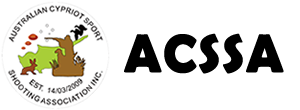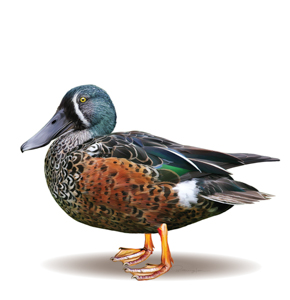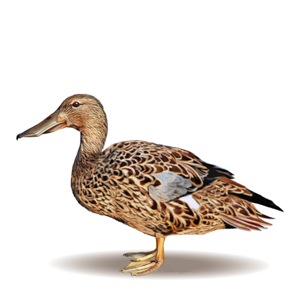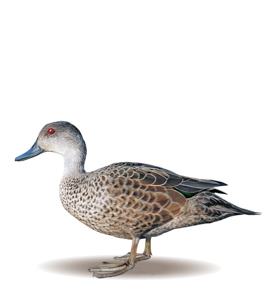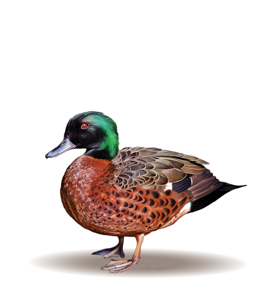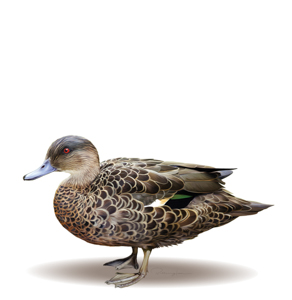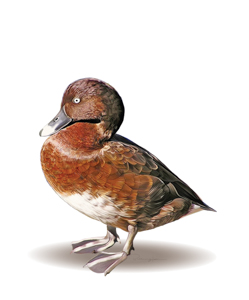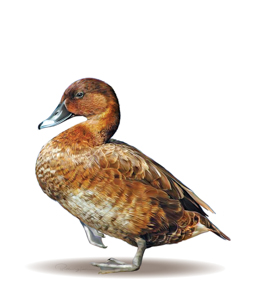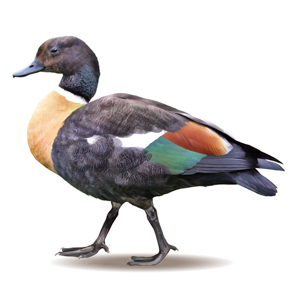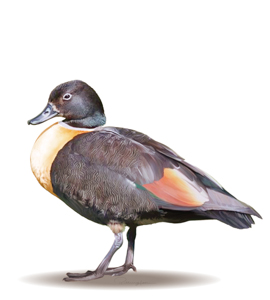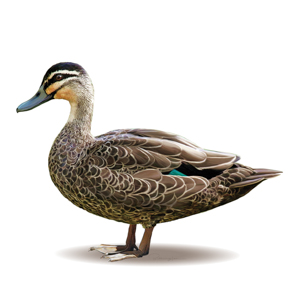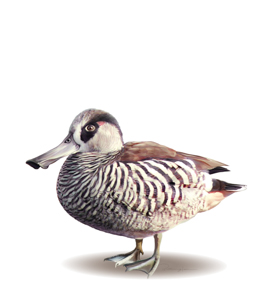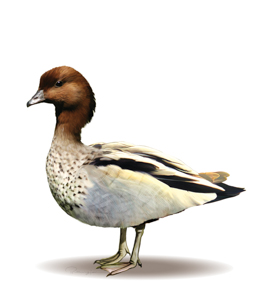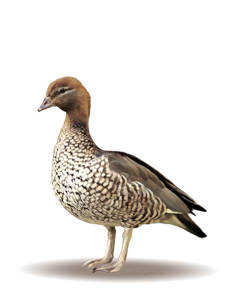Blue-winged Shoveler
|
Male |
Female |
Appearance
The Blue-winged Shoveler is a distinctive species with a slender build and a broad, blue-grey bill. The male is more colourful than the female and has a blue-grey head and neck, white face crescent, black back, a white patch on the rump and a deep chestnut-coloured belly. The colouring of the male fades when not in breeding condition. The male has bright yellow to orange legs and feet and is the only native duck to do so. The female is predominantly brown with a light chestnut-coloured belly.
In flight, the Blue-winged Shoveler has very quick wing beats with a distinctive whirr, white underwings, large pale patches on upperwing and the male has bright orange legs. In flight, the Blue-winged Shoveler appears much darker than other waterfowl and the wedge-shaped head is obvious. On the water, the Blue-winged Shoveler is a medium-sized duck which floats low, has a distinctive wedge-shaped head and the male has a white patch on its rump.
Habitat and distribution
The Blue-winged Shoveler can be found in all eastern states of Australia as well as from the south up to the north-west cape of Western Australia. In eastern Australia, it can be found from as far south as Tasmania to Cairns in the north. The species prefers permanent, well-vegetated wetlands with areas of open water. Habitat may be freshwater or saline. Usually an uncommon duck, the Blue-winged Shoveler is distributed throughout south-eastern and south-western Australia, preferring inland cumbungi swamps and coastal tea-tree swamps. Blue-winged Shovelers are seldom heard but do have a soft chatter when flying.
Grey Teal
Appearance
The Blue-winged Shoveler is a distinctive species with a slender build and a broad, blue-grey bill. The male is more colourful than the female and has a blue-grey head and neck, white face crescent, black back, a white patch on the rump and a deep chestnut-coloured belly. The colouring of the male fades when not in breeding condition. The male has bright yellow to orange legs and feet and is the only native duck to do so. The female is predominantly brown with a light chestnut-coloured belly.
In flight, the Blue-winged Shoveler has very quick wing beats with a distinctive whirr, white underwings, large pale patches on upperwing and the male has bright orange legs. In flight, the Blue-winged Shoveler appears much darker than other waterfowl and the wedge-shaped head is obvious. On the water, the Blue-winged Shoveler is a medium-sized duck which floats low, has a distinctive wedge-shaped head and the male has a white patch on its rump.
Habitat and distribution
The Blue-winged Shoveler can be found in all eastern states of Australia as well as from the south up to the north-west cape of Western Australia. In eastern Australia, it can be found from as far south as Tasmania to Cairns in the north. The species prefers permanent, well-vegetated wetlands with areas of open water. Habitat may be freshwater or saline. Usually an uncommon duck, the Blue-winged Shoveler is distributed throughout south-eastern and south-western Australia, preferring inland cumbungi swamps and coastal tea-tree swamps. Blue-winged Shovelers are seldom heard but do have a soft chatter when flying.
Chestnut Teal
|
Male |
Female |
Appearance
The Chestnut Teal is darker and a slightly bigger bird than the Grey Teal. In flight, the wedge-shaped white patch on both the upperwing and underwing is obvious. The male Chestnut Teal has a white patch on the flank which can also be seen in flight. The male is a dark bird with a very dark glossy-green head.
On the water, the Chestnut Teal is a small, dark duck which floats high. The male has a glossy-green head and a white flank patch. The female and juvenile male are similar to the drab Grey Teal, but are darker and lack the white throat.
Habitat and distribution
Most common in brackish coastal lagoons, saltwater estuaries and the lower reaches of creeks around the coast, the Chestnut Teal is distributed in south-eastern and south-western Australia. Vagrants may occur elsewhere. Tasmania and southern Victoria are the species’ stronghold.
Hardhead
|
Male |
Female |
Appearance
A medium-sized, dark-brown bird with white feathers under the tail. The male has a white eye.
In flight, the Hardhead has a large white band across the belly, the underwing is translucent white and the upperwing has a white strip on the trailing edge. The Hardhead is very swift in flight with rapid, short wing beats. The wings are narrow and pointed and set well back on the body.
On the water, the Hardhead is a dark coloured duck, floating very low and sometimes the white undertail is visible.
Habitat and distribution
The Hardhead is widely distributed throughout Australia, however, the stronghold of the species is in the deeper, permanent freshwater swamps and lagoons of the Murray-Darling Basin and south-east South Australia. They are also common in south-west Western Australia.
Mountain Duck
|
Male |
Female |
Appearance
The Mountain Duck is the largest Australian duck. Its dark body contrasts with brilliant white wing patches.
In flight, the Mountain Duck has large, prominent white wing patches on the shoulders of the wing, a dark body, white underwings, chestnut-coloured breast and a white neck ring.
On the water or land, a large duck with a dark head, white neck ring, yellow-brown or chestnut-coloured breast.
The female and young birds have a white ring around the eye and a white face patch.
Habitat and distribution
Mountain Duck are distributed throughout south-eastern and south-western Australia and inhabit lowland wetlands, both freshwater and saline, which are near pastures or arable land. Being grazers, they feed in pastures, cultivated crops and shallow water.
Pacific Black Duck
|
|
Appearance
The Black Duck is a major game species in Victoria and is a large duck. It is a dark-brown bird with a pale face and throat. It has a distinctive black eye-stripe that stretches from the top of the bill through the eye. The male and female have a similar appearance.
In flight, the Black Duck is a dark bird with swift wing beats and a slender neck. The upperwing has no white but does have a green, glossy colour patch on it. The underwing is white.
Habitat and distribution
The Black Duck is common and widely distributed throughout Australia and across a wide range of habitats, from deep, permanent, reed-dominated freshwater wetlands to rivers, creeks and brackish or saline wetlands.
Pink-eared Duck
|
|
Appearance
In flight, the head is held high with the heavy bill angled downward. The species has a light underbody, white trailing edges on upperwing and tail and a white crescent on the rump. The wings are rounded.
On the water, a small, light-coloured duck floating high with zebra stripes on body, a large bill and distinctive forehead. The male and female have a similar appearance.
Habitat and distribution
The Pink-eared Duck is widely distributed throughout inland south-eastern Australia and south-western Australia, however, vagrants occur elsewhere. The Pink-eared Duck prefers shallow, temporary waters, however, extensive open wetlands support large flocks at times.
Wood Duck
|
Male |
Female |
Appearance
The Wood Duck is a medium-sized goose-like duck with long legs, extended neck, short head and is related to the pygmy-geese of tropical Australia.
In flight, the Wood Duck has slow wing beats, large white patches on the rear of the upperwing near the body and a white triangle on the upperwing near the body. The male has a black undertail and belly while the female has a white belly and dark eyestripes.
On the water or on land, the Wood Duck is a medium-sized, light-coloured duck with a dark head, a characteristic high-tailed posture on water and erect posture on land.
Habitat and distribution
The Wood Duck is widely distributed and is common throughout Australia. However, it is rare and considered to be a vagrant in tropical Australia. Wood Duck prefer lightly timbered country near water, be it swamps, dams, rivers or other waterways, where there is short grass or herbage beneath the trees. It is seldom found in dense or extensive swamps and avoids brackish or saline water.
